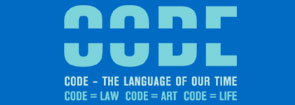| |
|
|
|
|
||
|
||||||||||||||||||||
| |
|
|
|
|
 |
|
 |
|||
| |
||||||||||
| |
||||||||||
 |
|
|||||||||
| |
||||||||||
| |
||||||||||
| |
||||||||||
| |
 |
|
Roman Verostko at the CODE Symposium
Roman Verostko (USA), is one of the first artists to employ original coded procedures for generating art forms. His interest focuses on coded drawing procedures. Roman Verostko, artist, historian, and MCAD Professor Emeritus, was born in 1929 in the coal fields of Western Pennsylvania (USA). As a child he made his first paintings using a mail-order paint set. In the early 1980's, following 30 years of painting, he began executing algorithmic drawings with a pen plotter. Today his studio includes a network of computers coupled to pen plotters driven with his own original software. By 1987 he had created the world's first software driven "brushed" paintings with oriental brushes mounted on his pen plotter. His studio integrates coded digital procedure with fine arts traditions. "In the last quarter of the 20th Century the form-generating power of algorithms executed with computing power seized the imagination of a number of artists. These coded procedures are of a different order than traditional procedures. How shall we label this process? This was a question that my wife, Alice, and I posed in 1986. In our search we found ourselves returning again and again to similarities between biological processes and coded procedures. We settled on the term "epigenetic" and this became the basis for my 1988 paper on Epigenetic Art. Epigenesis refers to the process whereby a mature plant, the phenotype, grows from a seed, the genotype. For example an acorn embodies the genotype or code that contains the information needed for growing a mature oak tree. Given the proper environment it can, in time, grow into a mature tree, the phenotype. The "growing" process is called epigenesis. By analogy my code, likened to genotype, contains the information needed for generating an art form. Given the proper studio environment the code literally grows an art form. By analogy to biological epigenesis, this process may be viewed as epigenetic. Clearly any coded procedure that has the information necessary for generating an art form can be viewed as epigenetic. The more general term in current use is "generative art." For over a quarter century generative art has been creating the icons of our information age. These icons emerge as diagrams or visual analogues to the coded procedures by which they were made. The essential character of each finished work is derived from the "form-generating-procedure" or "algorithm" acting as genotype. For this reason the finished work becomes an epiphany, or manifestation, of its generator, the code. For me, each work celebrates the code that shaped its character. It is noteworthy that such procedures hold much in common with processes associated with crystallization and genetics. In general these works provide a window on unseen processes shaping mind and matter. By doing so they become icons illuminating the mysterious nature of self, earth and cosmos." (Roman Verostko) |  |
|
|||||
| |
||||||||||
| |
Ingrid Fischer-Schreiber |
|||||||||
| |
 |
|||||||||
| © Ars Electronica Linz GmbH, info@aec.at | ||||||||||